How to find redfish spots is a critical skill for success in the marsh. It's important when specifically targeting them but also when you are not. Remember, it is Plan Redfish that may save your fishing trip when the specks are not biting!
Finding Redfish Spots
Redfish behave differently from their inshore cousins, preferring to patrol shorelines in shallower water. But what kind of shallow water is going to have the best redfish action?
First, it's important to understand there are three different kinds of redfish:
- rat reds
- slot reds
- bull reds
The focus of this article is slot reds, or redfish between 16"-27" in length, and maybe a little over, upwards of 30 inches.
Rat reds are under 16" and, since they are illegal to keep (and not much fun catching) I am ignoring them in this article.
Really big bull redfish are not the focus of this article, either. In some ways they do behave like slot reds, but are mostly found in "big water" and act differently.
A Note on Bull Reds
Bull reds exist inside the marsh but are mostly caught on the outside. They frequent deeper water with moving current and are often found feasting on school trout.
Bull redfish are sexually mature and travel in enormous schools during the summer and fall. They school up to spawn en masse, similar to speckled trout.
In fact, this popular video routinely makes its way around social media, as it aptly demonstrates what this behavior looks like.
Where are the Redfish?
Redfish love shallow water, especially shallow water with cover like aquatic grass. In some cases it is not uncommon to see them swimming in water so shallow their backs and tails are sticking out!
However, it's not just any shallow water redfish are attracted to, but shallow water with specific features.
While they are not all necessary, here are some I look for:
Shallow
It's obvious but cannot be overstated.
Find. Shallow. Water.
This is water from anywhere less than a foot to four feet deep. Otherwise the likelihood of you stumbling across a pile of redfish in water deeper than that is slim to none.
Plus, you want to be able to see them and shallow water makes this easy.
Clean
You want water that is clean.
Water that looks like chocolate milk is no good. While redfish have thicker gills allowing them to endure these conditions, they will still seek cleaner water easier for them to breathe and feed in.
Different Kinds of Clean Water
You should understand that there are different kinds of colored water. There is green, blue, black and more.
Green water is usually saltier water, colored green. Same for blue water.
Blackwater looks like tea or root beer. It is still transparent and free of suspended particles and silt, but not clear like tap water.
A lot of ponds you will encounter have this kind of water and redfish thrive in it.
Aquatic Grass
In Finding the Pumpkin Patch I harp on locating aquatic grass. While this is not a prerequisite for smashing redfish, it is a plus.
With that said, I have seen and caught a lot of redfish in places where there is zero aquatic grass.
On many days I like to fish areas with no grass because it is easier; I don't get hung up and can throw non-weedless baits.
Redfish like aquatic grass because it puts more oxygen into the water. If you spend enough time sighting them from the vantage point of a stand, you will see redfish "sleeping" inside the grass.
You can bounce a lure in front of their face but they won't "wake up" until you hit them with it. When they do wake, they usually run away scared.
There are all kinds of aquatic grasses ranging from hydrilla to turtle grass to snot grass.
Presence of Baitfish
Aquatic grass also provides cover for baitfish like minnows, mullet, shrimp, crabs and more. If I don't see these things I don't stick around long.
When scouting for redfish I am always excited to see stingrays. Where I see stingrays in a shallow area I know I will also see redfish. It happens every time, almost like clock work.
This is because stingrays and redfish are looking for the same forage.
Redfish will follow stingrays to pick off fleeing bait.
Where Credit is Due"]Credit for this observation goes to Lou Paretti, also know as "Lou Da Fish." Today, I am always looking for stingrays when searching for redfish.
He is an accomplished inshore angler with great advice to offer. In fact, you can listen to him talk about redfish and stingrays in Episode Five of my podcast, Inshore Interviews.
Broken Marsh
This is not a prerequisite but certainly something to pay attention to. Generally, if an area in the marsh is broken up then chances are it is shallow and redfish can be caught there.
This is usually due to erosion, so if you look at satellite images over a period of time then you can see this take place.
Presence of Tide
I don't think tide is super important to redfish, but in some areas it can be key. Some ponds have tidelines moving through them.
If you don't understand tidelines or why they are important, then check out Scouting: Locating Tidelines that Hold Fish and Mastering the Tide.
Baitfish like shrimp and blue crabs can blow in along those tidelines and compel redfish to stay in the vicinity.
Tools for Locating Redfish
My favorite tool for finding good redfish spots is Google Earth. If you have been following the Blog for awhile you know it is my absolute favorite!
You should download Google Earth to your computer (it's free) and begin playing with it.
I have this awesome article about using Google Earth to aid you in your education.
Features of a great redfish spot can be detected using satellite imagery on Google Earth. Let's take a look at some of these great, and not so great, redfish spots.
Example 1 - Tiny Ponds
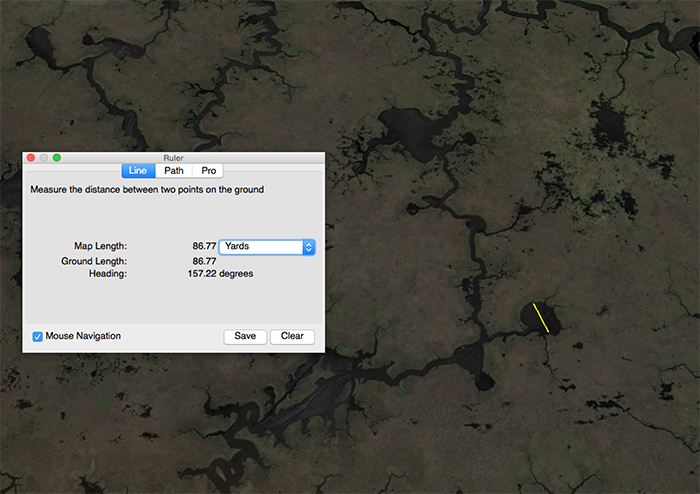
Not all redfish spots are created equal. Just because it's a shallow pond doesn't mean reds are thriving there.
Remember that redfish will go as shallow as they can. Does that mean they will be in ponds located at the extreme edges of navigable water?
Example 1 looks like it would be a great area for redfish. In fact, I bet there are some swimming there right now, but only one or two.
Aren't we looking for a lot of redfish?
Redfish won't be congregating in numbers in a spot like this because it's not big enough to accommodate them. The pond is too small to keep a lot of redfish comfortable and well fed.
I have fished many spots like Example 1 and I may see a redfish or two, but rarely do I see a lot of them.
Example 2 - Grass Mats
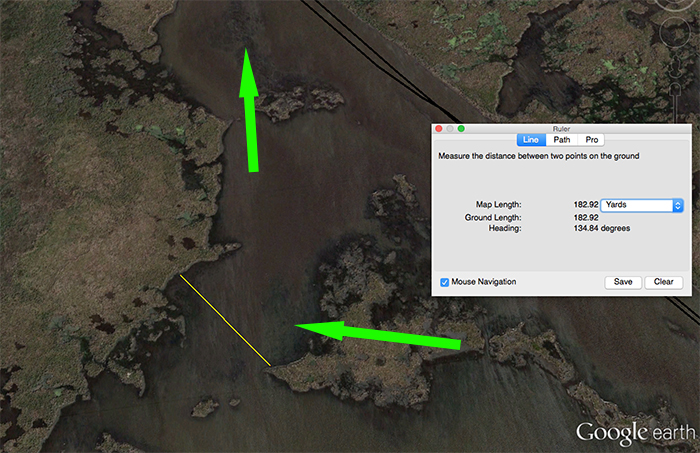
The green arrows are pointing to aquatic grass.
Redfish love aquatic grass and in this photo we can see a little of it. Grass grows so thick it will mat on the surface making it visible on satellite imagery. This is indicates redfish may congregate here and this spot is worth checking out.
Aquatic grass will "scrub" water, removing suspended particles and making it clean. On one side of a thick grass mat the water will be clean and on the other side the water will be muddy.
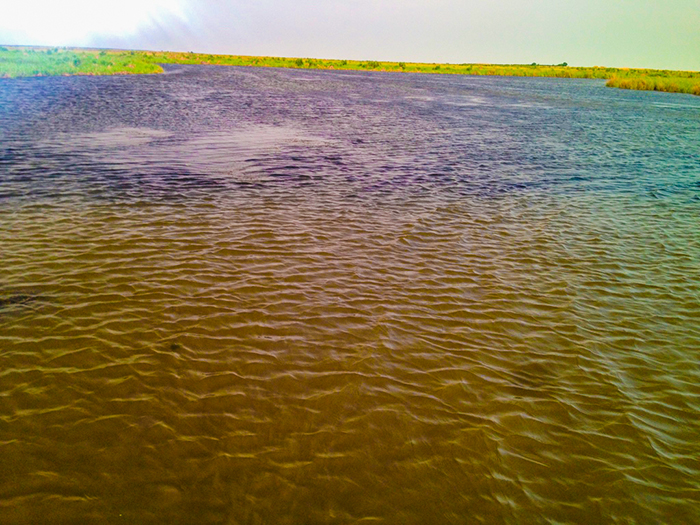
Note how the water is clean on one side of the grass line and dirty on the other. The "calm" spots you see on the water are the top of the grass mats.
Keep in mind that aquatic grass dies when it gets cold or too salty. Areas influenced by high water from the Mississippi can have lots of aquatic grass and then virtually none later in the year. Factor this in while you are scouting.
Example 3 - Eroded Ponds
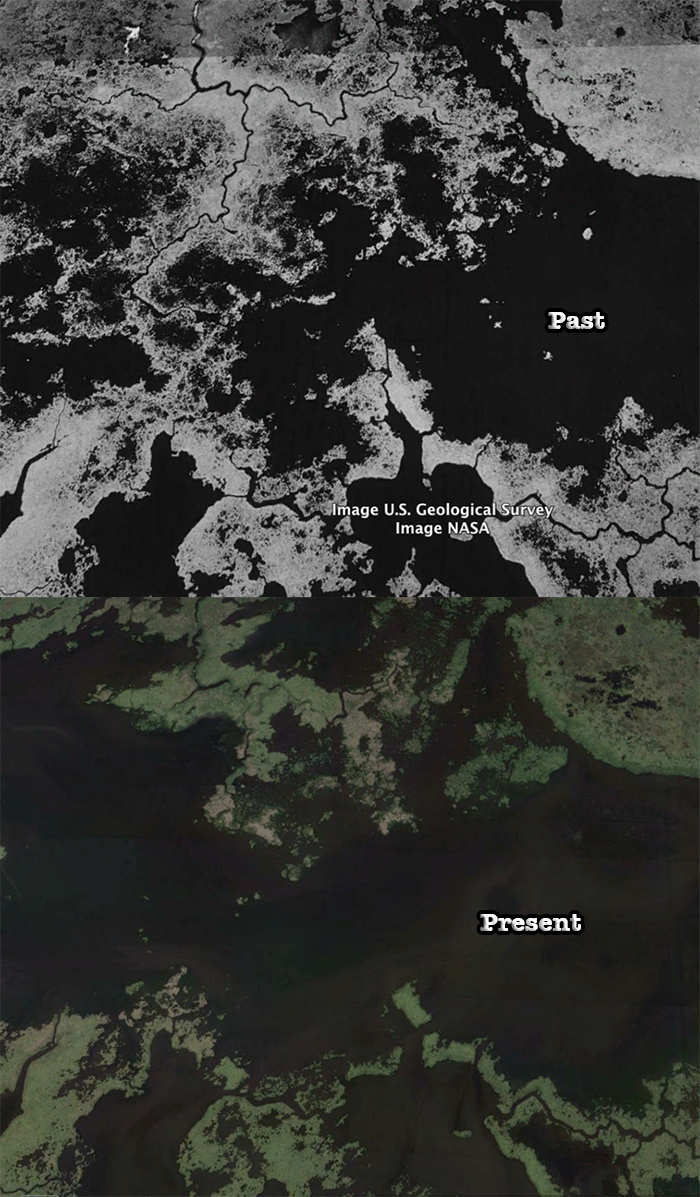
This marsh has eroded away due to storm surge from hurricanes. It's a great place to catch redfish because it is shallow and has broken up marsh.
This area is great for redfish. It has eroded so much it is hardly recognizable, but you can pair up a trenasse or two to see it is in fact the same area.
I like targeting these for reds, but be warned: they are ultra shallow.
Example 4 - Clean vs Dirty
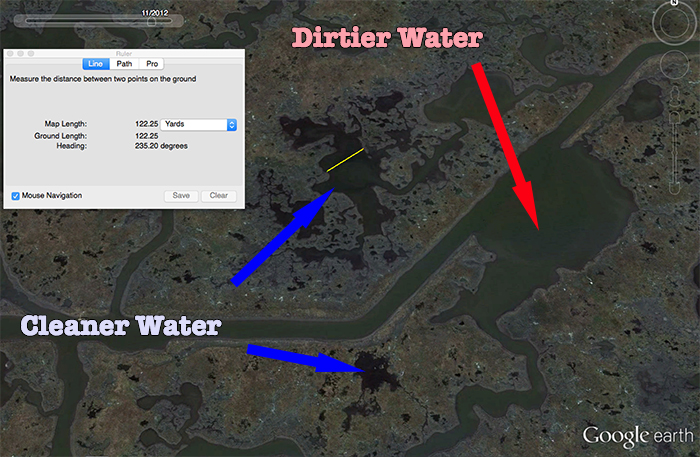
Dark is clean, lighter is not.
Remember redfish love clean water!
The darker-colored water is clean whereas the lighter-colored water is actually dirty.
That doesn't mean redfish won't be in dirty water. I have caught lots of reds in dirty water! This just means you have a tool for locating clean water.
Knowledge Bomb
Google Earth has a historical time slider that lets you view satellite images from different points in time.
Some of these satellite images were taken a few days after a strong cold front blew through, such as October 29th, 2012 in the Biloxi marsh.
This is great because we can see where dirty was and where dirty water was not.
Obviously these satellite images are time sensitive, they were taken during conditions that no longer exist. However, they are still useful for the next time those conditions occur and you need to find clean water in that area.
Example 5 - Deep vs Shallow
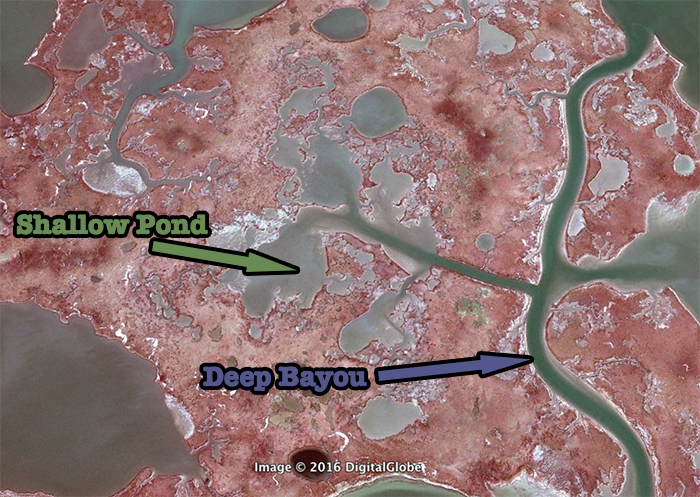
This is an excellent area to look for redfish!
While we can't see tidelines flowing across this pond (probably because it is not deep enough) I promise the tide moves through here and this is an excellent location to begin looking for reds.
I am confident I could go to this spot and catch them here.
This spot is great because it has a deep bayou going into a shallow pond.
If water levels are so low I can't get into the pond itself, I can still position myself in the bayou to cast into shallow water.
There is more to How to Find Redfish Spots
Keep in mind that at the end of the day you "have to go to know." Many spots I thought would hold huge gangs of redfish turned out to be complete garbage.
Other spots that I thought for sure would be dirty and devoid of reds turned out to be great.
Things can be weird at times and not make any sense. Just know the marsh is going to give you what she gives you and it is up to you to try.

Good luck! Be sure to let us know how you do inside LAFB Inshore.
Devin going tomorrow have been using google earth will be going to Dularge looking for redfish using your lesson plans.
Thanks for reading, John!
Nice article, with several useful tips, thank you very much!